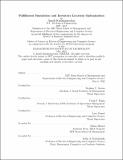| dc.contributor.advisor | Graves, Stephen C. | |
| dc.contributor.advisor | Farias, Vivek F. | |
| dc.contributor.advisor | Daniel, Luca | |
| dc.contributor.author | Krishnamachar, Anjali | |
| dc.date.accessioned | 2022-11-30T19:41:38Z | |
| dc.date.available | 2022-11-30T19:41:38Z | |
| dc.date.issued | 2022-05 | |
| dc.date.submitted | 2022-08-25T19:15:32.873Z | |
| dc.identifier.uri | https://hdl.handle.net/1721.1/146691 | |
| dc.description.abstract | For a large, global retailer, the expansion towards digital business has motivated a shift in supply chain strategy. The retailer is in the process of transitioning from traditionally using national hubs for fulfillment to specifically targeting digital demand hotspots as new fulfillment centers. As this strategy is developed, the retailer requires the capability to quickly test out potential network configurations in a simulated manner before implementing these system changes in the distribution network. The retailer would also like to explore how key system parameters, such as inventory placement, can be optimized to improve fulfillment performance throughout the network.
This thesis focuses on two main topics: the improvement and automation of an existing sim- ulation framework used for simulating digital fulfillment and the development of an optimization formulation for recommending inventory positions that will improve fulfillment metrics. We demon- strate a pilot test of both topics by using the improved simulation framework to compare several fulfillment scenarios, including one with inventory positions that are dictated by the developed opti- mization method. First, the inventory optimization is executed over a historical dataset of orders to find recommended inventory positions. Then, the simulation framework is used to simulate digital fulfillment under two types of scenarios: inventory placed at the recommended positions and inventory placed at the original historical positions. The resulting simulated fulfillment performance is compared between the scenarios and we show that the scenario with recommended inventory positions is able to achieve a 6.7% reduction in unit shipping cost as well as a 25% reduction in the percent of total fulfilled orders that require split shipments. These initial results are promising in their demonstration of potential avenues for improving digital fulfillment via inventory optimization as well as the use of simulation as a tool for digital fulfillment network comparison. | |
| dc.publisher | Massachusetts Institute of Technology | |
| dc.rights | In Copyright - Educational Use Permitted | |
| dc.rights | Copyright retained by author(s) | |
| dc.rights.uri | https://rightsstatements.org/page/InC-EDU/1.0/ | |
| dc.title | Fulfillment Simulation and Inventory Location Optimization | |
| dc.type | Thesis | |
| dc.description.degree | S.M. | |
| dc.description.degree | M.B.A. | |
| dc.contributor.department | Massachusetts Institute of Technology. Department of Electrical Engineering and Computer Science | |
| dc.contributor.department | Sloan School of Management | |
| mit.thesis.degree | Master | |
| thesis.degree.name | Master of Science in Electrical Engineering and Computer Science | |
| thesis.degree.name | Master of Business Administration | |
